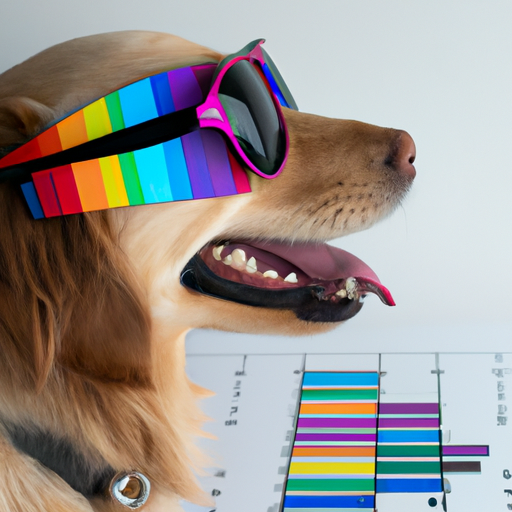Have you ever wondered what the world looks like through your dog’s eyes? How do they see the rainbow, the grass, or their favorite toy? Understanding color perception in dogs can deepen your bond with your furry friend and improve your ability to meet their needs.
Understanding Canine Vision
Contrary to popular belief, dogs do not see the world in black and white. Their vision is just not as colorful as ours. Dogs, like humans, have two types of color receptors in their eyes: rods and cones. Rods handle low-light vision and motion detection, while cones deal with color perception.
While humans have three types of cones that allow us to see a broad spectrum of colors, dogs only have two. This means they see the world in a dichromatic color scheme, equivalent to a human with red-green color blindness.
The Color Spectrum for Dogs
The canine color spectrum is primarily composed of two colors: blue and yellow. Here’s a breakdown of the colors:
- Blue: Dogs can see and distinguish various shades of blue.
- Yellow: Dogs can also see and distinguish various shades of yellow.
- Green, Yellow-Green, and Orange: These colors would likely appear as varying shades of yellow.
- Violet: This color would likely appear as a different shade of blue.
- Red: This color would likely appear as dark brown or even black to a dog.
Here’s a quick reference table:
| Human Color | Dog’s Perception |
|---|---|
| Blue | Blue |
| Yellow | Yellow |
| Green | Yellow |
| Violet | Blue |
| Red | Dark Brown/Black |
Why Dogs’ Color Vision is Different
Evolution is the primary reason dogs see the world differently. In the wild, dogs’ ancestors needed to be able to detect movement and see clearly in low light conditions, which is why their eyes developed more rods. The ability to distinguish colors was less vital for survival, so dogs developed fewer cones.
Practical Applications of Dogs’ Color Vision
Understanding your dog’s color vision can be useful in various ways. For example:
- Choosing Toys: Opt for toys in colors your dog can see clearly, such as blue or yellow.
- Training: You can use colors to help with training cues. For example, a blue mat to signal ‘sit’ and a yellow mat for ‘stay’.
- Safety: Knowing your dog struggles with red can help you avoid potential hazards, such as not relying on a red stop signal during walks.
Frequently Asked Questions
1. Can dogs see in the dark better than humans?
Yes, dogs have better low-light vision than humans due to having more rods in their eyes.
2. What colors can dogs not see at all?
Dogs cannot distinguish red and green. These colors likely appear as different shades of brown or black.
3. Do all dogs see the same colors?
While there may be individual variations, generally all dogs see the same range of colors.
4. Can dogs see TV or computer screens?
Yes, but they may perceive the images differently due to their different color spectrum and motion sensitivity.
5. Why does my dog’s eyes glow in the dark?
This is due to a layer in their eye called the tapetum lucidum, which helps them see better in low light.
As a caregiver, understanding your dog’s world through their eyes can help you better cater to their needs and ensure their wellbeing. So, the next time you’re out with your dog, remember – they’re seeing the world in a whole different color.



